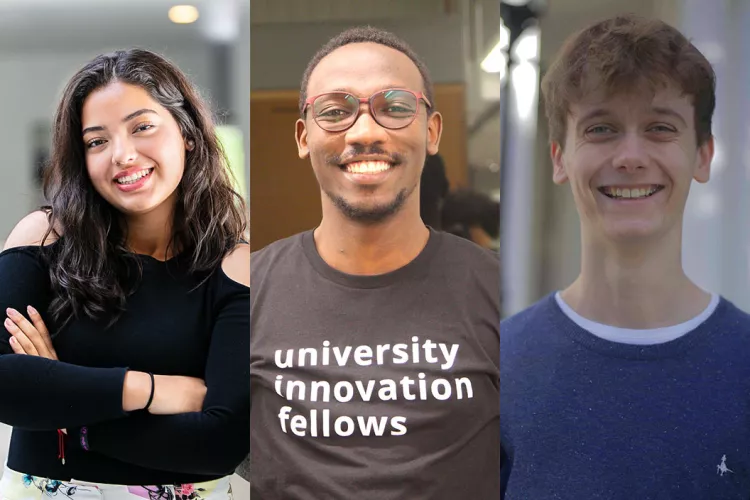Three Students Named Stanford Innovation Fellows

From left: Fiorenza Herrera Diaz ’21, Haron Kalii ’23, and Edward Tranter ’22 join this year’s cohort of Stanford University Innovation Fellows, building on their experiences as design interns with Swarthmore’s Center for Innovation and Leadership.
Three Swarthmore students have been named Stanford University Innovation Fellows (UIF), an honor bestowed upon students who have completed six weeks of intensive training designed to fuel campus leadership, innovation, and entrepreneurship.
Fiorenza Herrera Diaz ’21, Haron Kalii ’23, and Edward Tranter ’22 join this year’s cohort, building on their experiences as design interns with Swarthmore’s Center for Innovation and Leadership (CIL). They will foster opportunities for peers to unlock their creative potential and develop the design-centered mindset required to take on complex challenges in today’s world.
“I’m extremely excited to become part of the Stanford Innovation family and to work on my projects with the CIL,” says Tranter, an honors political science major from Great Britain. “I hope to develop my design-thinking skills and to reinvent how we make change at Swarthmore.”
“We’ll work to address the new challenges that arise from a virtual environment to ensure all students have access to the opportunities Swarthmore offers,” adds Diaz, an economics and peace & conflict studies major from Wilmington, N.C. “I’m excited and grateful to be part of this team.”
Run by Stanford’s Hasso Plattner Institute of Design, the UIF program amplifies the student voice in the global conversation about the future of education. Fellows are immersed in the innovation and entrepreneurship ecosystem at their schools, working closely with faculty, administrators, and community stakeholders.
“We are thrilled to have our CIL design interns go through the Stanford training program in design-thinking so they can learn the process and use it to positively impact the campus community at Swarthmore,” says Katie Clark, assistant dean of integrated learning and leadership and director of the CIL.
Each of the fellows outlined a strategic priority to expand design-thinking at Swarthmore. Kalii will focus on giving students more guidance on how to turn innovative ideas into implementable projects. He designed a 10-week course on systems thinking, to be offered this spring, to guide student innovators through the project-design process and establish a “feedback channel” between new and experienced innovators.
“Through this fellowship, I have been challenged to think not just about the Swarthmore innovation and entrepreneurship ecosystem, but also to find gaps that I can fill,” says Kalii, a mathematics and economics major from Kenya. “I’m thankful that I get to be part of an auspicious team of fellows, all of whom are very passionate about innovation at Swarthmore College.”
As a result of the shift to online learning, Diaz noted that many students feel detached from the innovation ecosystem on campus and lack motivation to pursue extracurricular activities. She is designing a one-day virtual design-thinking challenge in partnership with the CIL and Innovations Program of Haverford College. Participants will collaborate to address a challenge presented by the city of Philadelphia, seizing the chance to connect with fellow innovators and earn a certificate that attests to their skill development.
“Their experience would motivate them to apply design-thinking to other challenges they face,” Diaz says, “and establish a connection to the innovation resources available at Swarthmore.”
Tranter’s focus will be putting innovation onto the radar of students earlier in their time at Swarthmore. He notes that students from liberal arts institutions are facing a tougher job market, requiring more experience with design-thinking than ever before.
“Although the term ‘social entrepreneurship’ has become less vague for students since my first year at Swarthmore, there’s still work to be done,” he says. “Through this Stanford training, we have upgraded our design-thinking skills, and we feel ready to take this problem on.”



